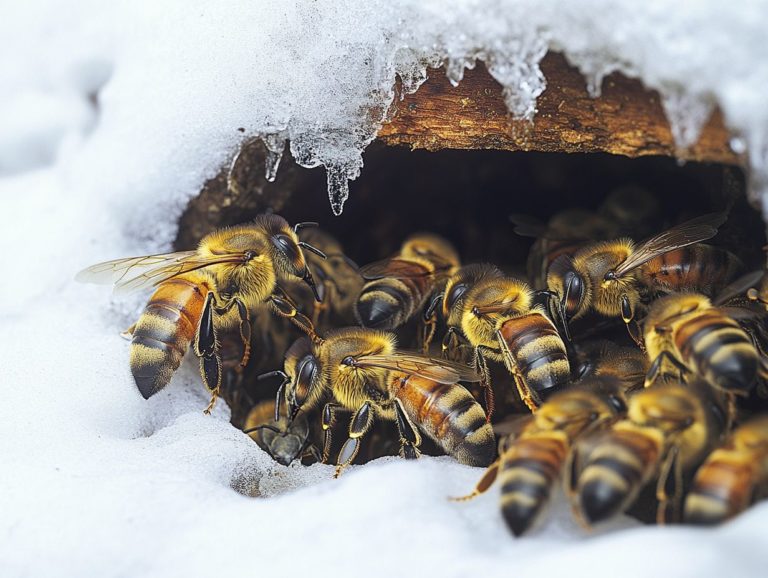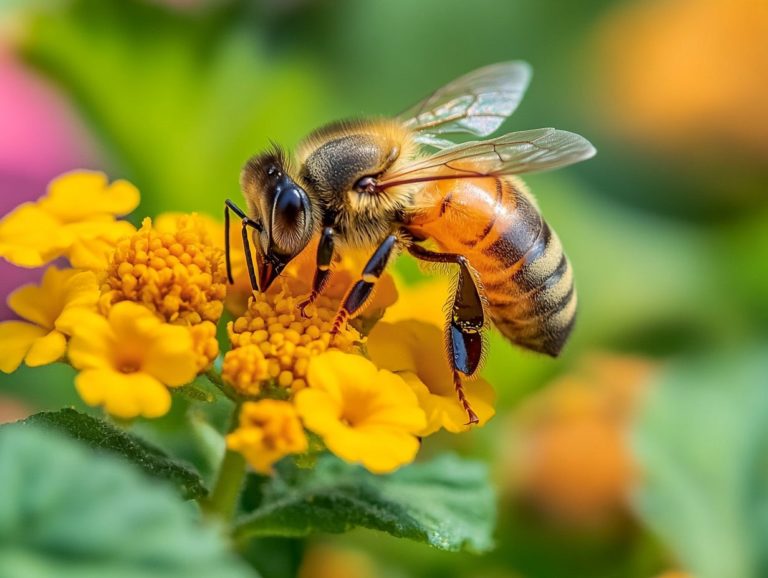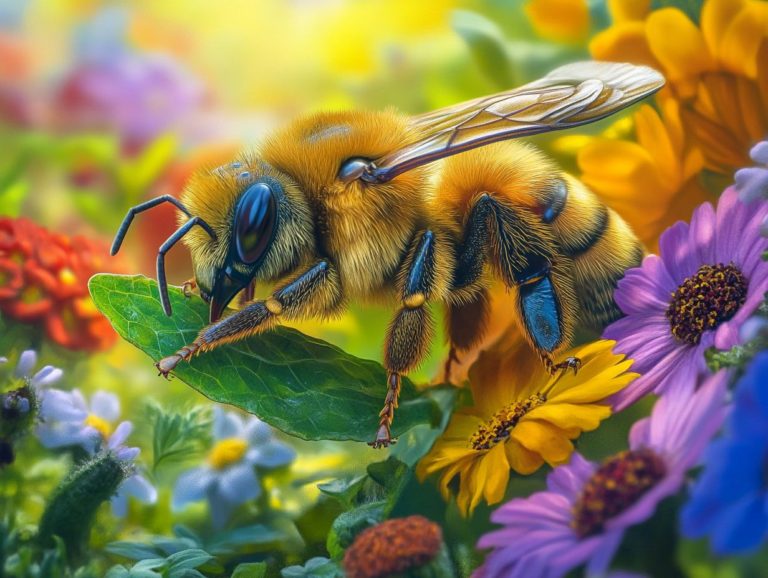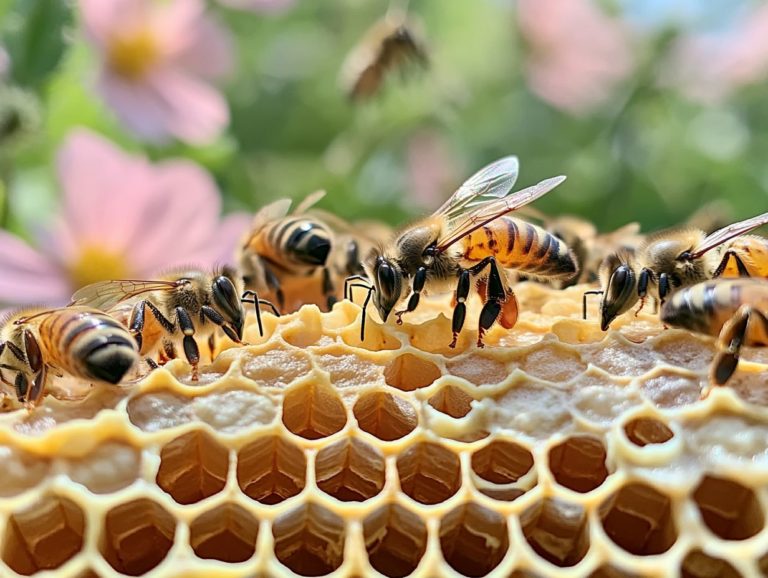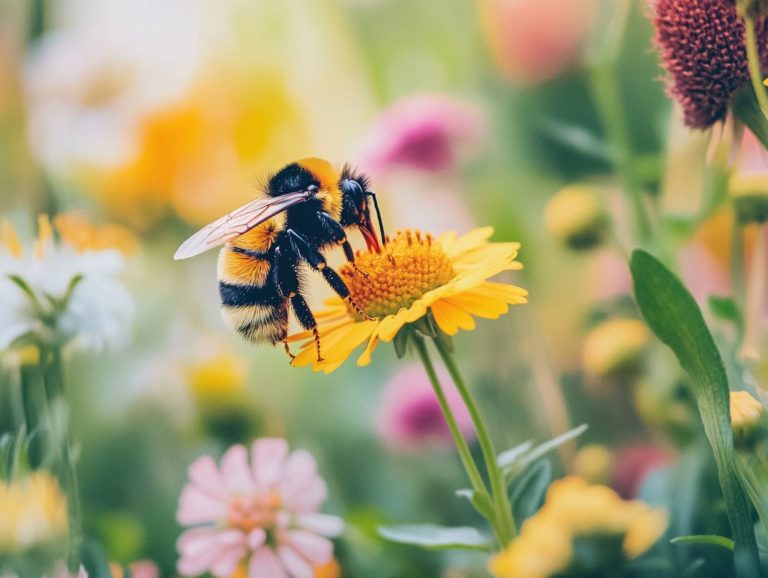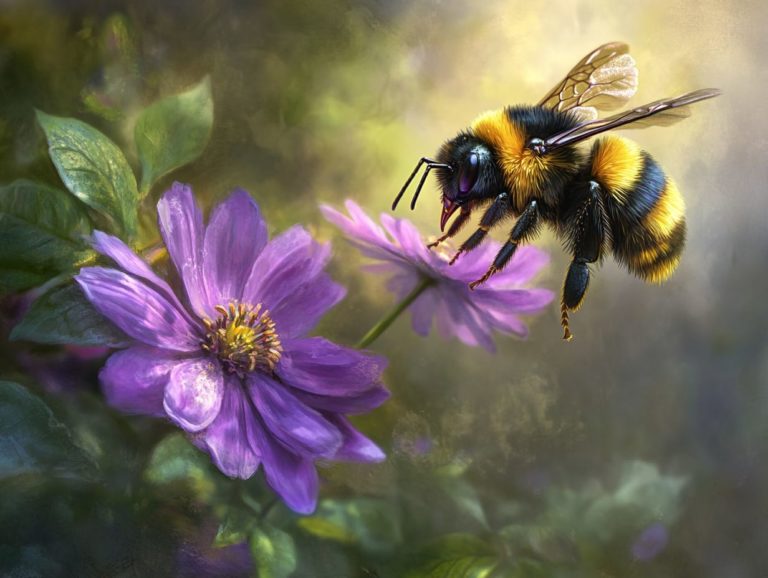The Benefits of Keeping Native Bees
Native bees are essential pollinators, vital to the health of our ecosystems and agricultural practices. They play a crucial role in the survival of species like macadamia and almond trees.
In contrast to honeybees, these extraordinary insects foster biodiversity by nurturing a myriad of plant species and bolstering local food production. This fact is highlighted by experts like Rachael Winfree and organizations like the Xerces Society.
Delve into the significance of native bees, uncover their advantages for gardens and ecosystems, and learn effective strategies to attract them. You’ll also encounter the fascinating variety of species, such as the American bumblebee and Tetragonula carbonaria, that might inhabit your area.
Join us in supporting these crucial pollinators and making a lasting impact, as emphasized by experts like Scott Black, Claire Kremen, and Sarah Foltz Jordan.
Contents
- Key Takeaways:
- What Are Native Bees?
- Why Are Native Bees Important?
- What Are the Benefits of Keeping Native Bees?
- How to Attract Native Bees to Your Garden?
- What Are Some Common Types of Native Bees?
- How Can You Support Native Bees in Your Community?
- Frequently Asked Questions
- What are the benefits of keeping native bees?
- How do native bees help with pollination?
- Will keeping native bees benefit my garden?
- How do native bees contribute to a sustainable ecosystem in the United States?
- Are there any economic benefits to keeping native bees?
- How can I support and encourage native bees in my area?
Key Takeaways:
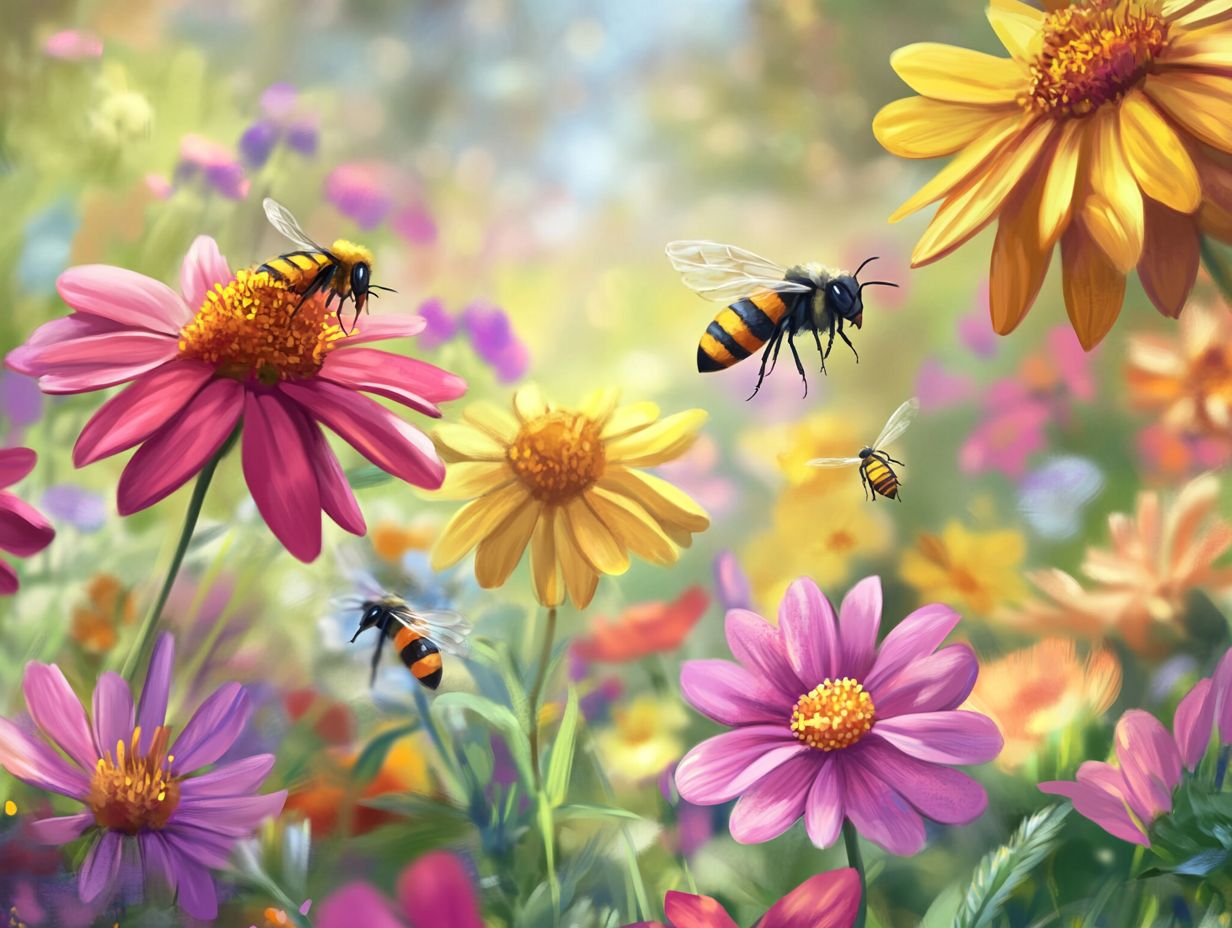
- Native bees are crucial for the pollination of gardens and crops, contributing to the production of food and plants.
- Keeping native bees supports local ecosystems, as they play a vital role in maintaining biodiversity and sustaining other plant and animal species.
- Attracting and preserving native bees helps conserve endangered species and protects the delicate balance of our environment.
Rachael Winfree has extensively studied the impact of native bees on various ecosystems, highlighting their crucial role.
What Are Native Bees?
Native bees, such as honey bees (Apis mellifera), blue orchard bees, and rusty-patched bumblebees, are invaluable to our ecosystems. They serve as vital pollinators and enhance biodiversity. While honey bees thrive in social colonies within hives, solitary bees like the common carpenter bee and Perdita minima prefer to nest independently.
These wild bees play an essential role in pollinating a diverse array of flowering plants. This, in turn, supports both natural habitats and agricultural systems throughout the United States.
Why Are Native Bees Important?
Native bees are vital in our ecosystems and agriculture. They act as crucial pollinators for a diverse array of flowering plants, fostering biodiversity and bolstering food production.
These remarkable creatures enhance the health of ecosystems and elevate crop yields. They are essential for sustainable agriculture and conservation initiatives.
What Role Do Native Bees Play in Pollination?
Native bees are absolutely essential to the art of pollination, a process vital for the reproduction of flowering plants and overall ecosystem health. By transferring nectar and pollen from one flower to another, these remarkable pollinators contribute to the growth of numerous crops and wild plants.
Take, for example, native bees like bumblebees and mason bees. They are renowned for their ability to pollinate a wide array of plants, including blueberries, tomatoes, and squash. Their unique behaviors, such as buzz pollination where they vibrate their bodies to release pollen showcase their incredible adaptations to the intricate structures of certain flowers.
This specialized interaction not only boosts the yields of these crops but also nurtures biodiversity within ecosystems by promoting genetic diversity among plant species. As native bees continue to flourish and perform their crucial pollination duties, they indirectly enhance agricultural productivity and foster a balanced environment. This underscores just how vital these insects are to both farming and the broader ecosystem.
How Do Native Bees Contribute to Biodiversity?
Native bees play a pivotal role in enhancing biodiversity by facilitating the reproduction of countless flowering plant species. This intricate relationship between native bees and plants nurtures diverse ecosystems. Various plant species rely on specific pollinators to thrive, weaving a rich tapestry of life.
The decline of native bee populations presents a significant threat to plant biodiversity. Many of these crucial pollinators have been classified as endangered, largely due to habitat destruction and environmental changes. As urbanization continues to spread and natural habitats shrink, the dwindling numbers of native bee species can result in decreased plant reproduction. This impacts food sources for other wildlife and risks destabilizing entire ecosystems.
It is crucial to prioritize conservation efforts to reverse this worrying trend. Initiatives that restore habitats and safeguard the natural environments of these bees can significantly enhance both their populations and the diverse flora they support. By cultivating healthy ecosystems where native bees can thrive, you also bolster the resilience of plant communities essential for maintaining ecological balance.
What Are the Benefits of Keeping Native Bees?
Keeping native bees offers a wealth of benefits that extend far beyond mere pollination. You enhance the vitality of your gardens and crops while supporting local ecosystems and contributing to the preservation of endangered native bee species.
By cultivating environments that nurture these vital pollinators, you play a crucial role in protecting biodiversity and promoting sustainable agricultural practices.
1. Increased Pollination of Gardens and Crops
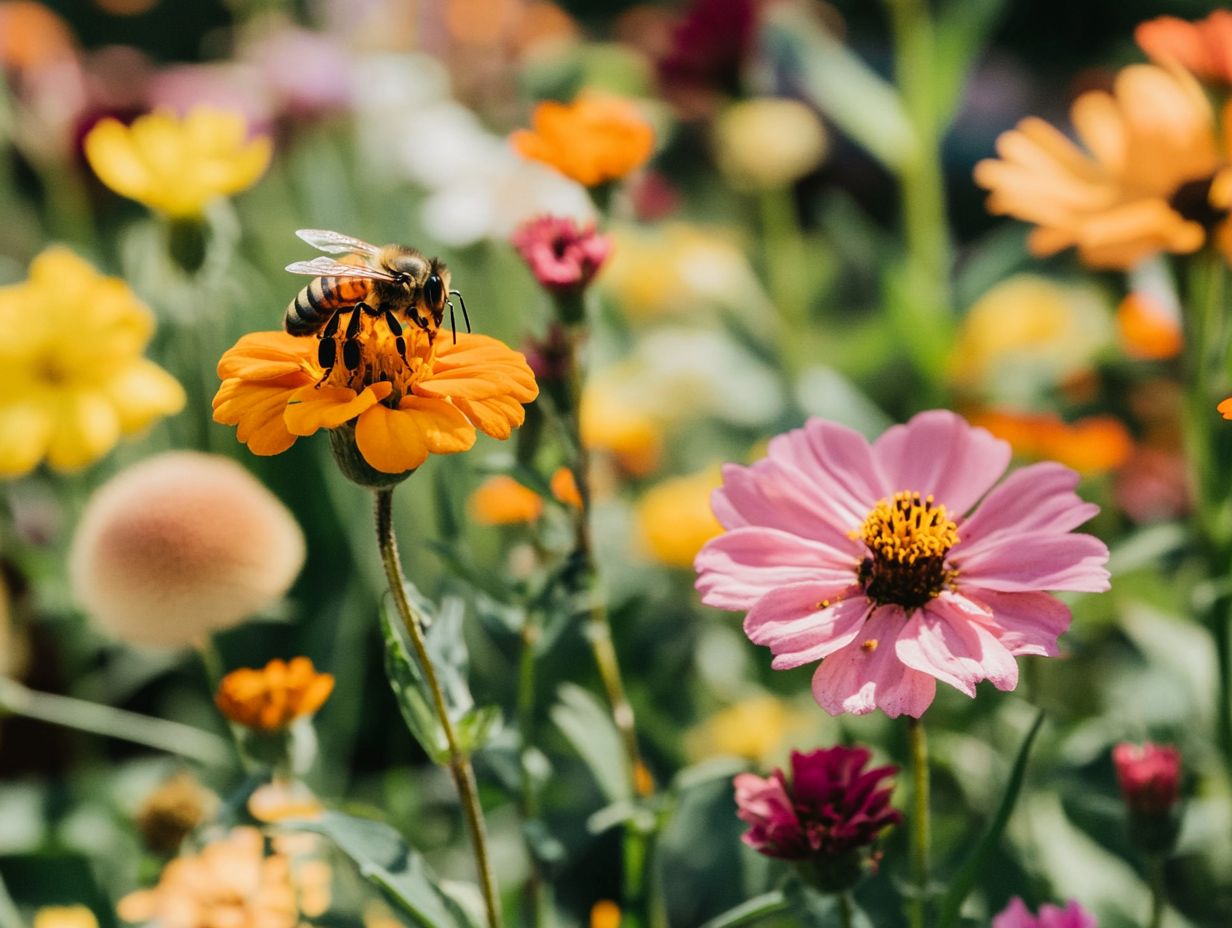
Increased pollination from native bees significantly boosts the yields in your gardens and crops, ranging from fruits and vegetables to nuts. Their efficient pollination services enhance both the quality and quantity of your produce, ultimately supporting local agriculture and food systems.
Unlike honey bees, native bees often specialize in pollinating specific plants, making them exceptionally effective in improving the health of various crops. For example, the blue orchard bee and mason bee excel at pollinating fruit trees, leading to better fruit set and larger sizes.
What s more, native pollinators are active even in cooler temperatures and during cloudy weather, providing you with reliable pollination service when honey bees might be taking a break.
This capability offers substantial advantages for you as a farmer or gardener. By investing in native bee habitats, you have the power to boost crop diversity and resilience, ultimately benefiting both the environment and your economic sustainability.
2. Supporting Local Ecosystems
Native bees play an essential role in supporting local ecosystems, and it’s vital for you to recognize just how important they are. By pollinating a diverse array of flowering plants, these industrious insects help maintain biodiversity, ensuring the health and resilience of local ecosystems. This interaction positively influences not only wildlife but also various plant species.
Their effectiveness as pollinators directly enables the reproduction of countless plants and the production of fruits and seeds that other species rely on for sustenance. These small but mighty insects contribute to habitat stability through their activities, promoting a balance that benefits both plants and animals.
Understanding their significance, numerous conservation efforts are currently underway to safeguard native bee populations. These efforts include:
Here are a few key ways to support native bees:
- Habitat restoration
- Reducing pesticide use
- Planting bee-friendly gardens
By supporting these initiatives, you can help ensure the survival of local native bee species and, in doing so, contribute to the ongoing health of the ecosystems they nurture.
Join the movement to protect native bees today!
3. Preserving Endangered Native Bee Species
Preserving endangered native bee species is essential for maintaining biodiversity and the ecological balance of your surroundings. Many native bees are under threat from habitat loss, climate change, and pesticide use, making conservation efforts crucial in protecting these vital pollinators.
The decline of these insect populations has far-reaching consequences, impacting not only the plants they pollinate but also the overall health of ecosystems that we depend on. To combat this decline, several conservation strategies are being implemented, including:
- Creating bee-friendly habitats
- Reducing pesticide usage
- Conducting scientific research to better understand their needs
Education plays a pivotal role in fostering community involvement, inspiring your friends and neighbors to join the cause! By raising awareness about the challenges these species face, you can contribute to conservation efforts, turning knowledge into actionable change that benefits both the environment and the future of bee populations.
Researchers from the USGS have also emphasized the importance of creating bee-friendly environments to support native bee populations.
How to Attract Native Bees to Your Garden?
Attracting native bees to your garden requires you to cultivate a welcome environment. This can be achieved by planting an array of native flowers, offering suitable nesting sites, and steering clear of harmful pesticides. Your garden can be a buzzing sanctuary!
The Finger Lakes region of New York is an excellent example of a community effort to support these bees. By nurturing a bee-friendly habitat, you not only support these vital pollinators but also elevate the aesthetic charm of your outdoor space, a principle supported by Environment America initiatives.
1. Plant Native Flowers and Plants
Planting native flowers and plants is one of the most effective strategies for attracting native bees, providing them with the essential nectar and pollen they need. Incorporating a diverse range of native plants ensures a continuous bloom throughout the growing season, promoting increased bee activity in your garden.
When selecting species, consider coneflowers, bee balm, and black-eyed Susans. Not only do these plants offer vibrant colors, but they also cater specifically to the foraging needs of various bee species, such as the blue orchard bee and the common carpenter bee.
For example, coneflowers bloom from early summer to fall, providing sustenance when other blooms have faded. Including early bloomers like crocus and spring beauty supports bees as they emerge from hibernation, while late bloomers like goldenrods extend the availability of resources into the fall months.
By embracing diversity, you not only help the bees but also enrich the soil and support wildlife! This approach enhances soil health and supports a variety of wildlife that depend on these plants for their survival, such as the rusty-patched bumblebee and the American bumblebee.
2. Provide Nesting Sites
Providing suitable nesting sites is crucial for supporting native bees, especially solitary ones that depend on specific habitats throughout their lifecycle, like the Perdita minima and the Tetragonula carbonaria. This might mean leaving bare ground for ground-nesting species or installing bee hotels (structures that provide nesting sites for solitary bees) to cater to cavity-nesting bees.
As a gardener, you can enhance the experience for these invaluable pollinators by creating a diverse array of small habitats that address the distinct needs of various bee species. For instance, sunny, undisturbed patches of soil make ideal nesting grounds for ground-nesters, while small bundles of twigs or hollow reeds can draw in those on the lookout for cavities.
Regular inspection and cleaning of bee hotels are essential for fostering a thriving environment. It s important to steer clear of tilling areas designated for ground-nesting, allowing bees the time and space to settle in and establish their homes. Additionally, regularly inspecting and cleaning out bee hotels will encourage continued habitation by keeping the spaces welcoming and pest-free.
This practice is vital for the health of bees in regions like California and the Finger Lakes.
3. Avoid Pesticides
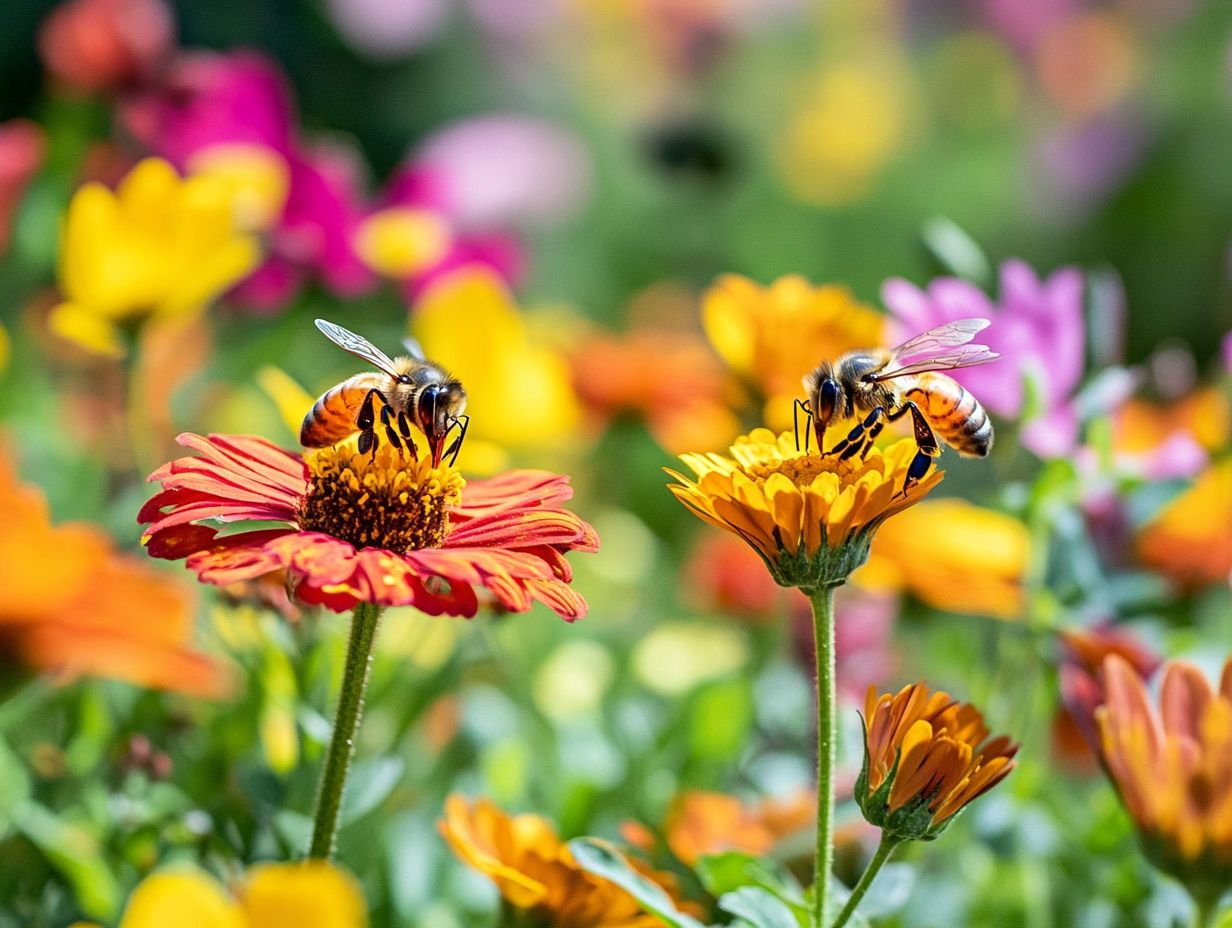
Avoiding pesticides is essential for conserving native bees, as these chemicals can seriously harm bee populations and disrupt their ability to reproduce. By cutting back or completely eliminating pesticide use, you can create a safer habitat for these vital pollinators.
As a steward of the environment, you must understand how crucial these bees are! The health of native bees directly affects ecosystem stability and food production. These essential creatures face many threats. Pesticide exposure is a significant factor in their decline.
To address these challenges, try using alternative pest control methods. A balanced approach to managing pests without harming bees combines biological, cultural, and mechanical control strategies methods that are not only effective but also beneficial for bee populations.
Implementing practices such as planting native flora, fostering beneficial insects, and using physical barriers can greatly enhance biodiversity while keeping your garden productive and vibrant. By prioritizing bee-friendly strategies, you play a vital role in supporting pollinators and nurturing a thriving ecosystem.
What Are Some Common Types of Native Bees?
Notable native bees in the United States include species like the blue orchard bee and the common carpenter bee. Each species has unique nesting and foraging behaviors that contribute significantly to local biodiversity and agricultural productivity.
You ll discover a fascinating array of native bees that play a vital role in pollination, including bumblebees, mason bees, leafcutter bees, and sweat bees. Each of these species brings its own unique contributions to the ecosystem, exhibiting a rich diversity of behaviors and distinct nesting preferences.
1. Bumblebees
Meet the bumblebee, one of the most recognizable native bees, known for their robust bodies and distinctive buzzing sound that signals their presence. As highly efficient pollinators, they thrive in a variety of habitats and are particularly effective in cooler temperatures compared to their bee counterparts.
These remarkable insects have a unique trick: they can vibrate their flight muscles, a technique known as sonication, which helps them shake pollen from certain flowers. With a strong sense of smell, they can easily locate food sources, such as nectar and pollen, from a wide range of plants, including wildflowers and agricultural crops like tomatoes and blueberries.
In terms of nesting, bumblebees typically choose abandoned rodent burrows or dense vegetation. Here, the females lay their eggs and care for their young after foraging for food. Their crucial role in pollination enhances the productivity of various ecosystems, boosts biodiversity, and ensures food security for many species, including humans.
2. Mason Bees
Meet the mason bee, a fascinating solitary pollinator renowned for their unique nesting habits. They often opt for existing cavities or hollow reeds to lay their eggs. These incredible creatures are essential for the pollination of early spring flowering crops, making them vital to both local ecosystems and agriculture.
In stark contrast to honeybees, which thrive in bustling colonies, mason bees are true individualists. Each female constructs her own nest, providing a secure environment for her offspring. They have a penchant for natural materials like mud and plant fibers, which they skillfully use to create partitions within their nests.
This solitary lifestyle allows mason bees to channel their energy into foraging for nectar and pollen, primarily from early-blooming flora such as fruit trees, blueberry bushes, almond trees, and flowering herbs. Their diligent activity not only boosts the yields of these crops but also fosters biodiversity within agricultural systems, supporting a diverse array of flowering plants crucial for maintaining a balanced ecosystem.
3. Leafcutter Bees
Leafcutter bees are truly remarkable pollinators, distinguished by their unique habit of cutting leaves and petals to craft their nests. Their solitary behavior and exceptional pollination capabilities render them vital players in the tapestry of biodiversity and plant reproduction.
These industrious insects significantly contribute to various ecosystems by nurturing the growth of flowering plants. As you observe them gathering plant materials for nest construction, you’ll notice that they inadvertently facilitate the process of transferring pollen from one flower to another to help plants grow across a diverse array of flora, including key agricultural crops like alfalfa and a variety of fruits.
Their preferred plants are often those boasting nutrient-rich leaves, serving not only as building materials but also ensuring that the larvae within their nests have access to a nutritious food source. This intricate behavior supports their lifecycle and enhances ecosystem health, promoting sustainable agricultural practices.
4. Sweat Bees
Sweat bees are small, metallic-colored native bees that seem to have a peculiar attraction to human sweat, a quirky behavior that aptly earns them their name. Despite their diminutive size, they are remarkably effective pollinators, thriving in a variety of habitats, making them invaluable contributors to local ecosystems.
These fascinating insects showcase a stunning array of colors, often shimmering in hues of green or blue, allowing you to easily spot them among other bee species. Their adaptability enables them to flourish in environments ranging from urban gardens to vibrant wildflower meadows. As they flit from blossom to blossom, they play a crucial role in pollinating plants like sunflowers, clover, and various fruit trees, each essential for sustaining biodiversity.
By facilitating cross-pollination, sweat bees not only promote healthy plant reproduction but also support a diverse range of wildlife, helping to maintain the delicate balance of our ecosystems. Their presence serves as a reminder of nature’s intricate web, emphasizing the significance of even the smallest creatures in nurturing our planet.
How Can You Support Native Bees in Your Community?
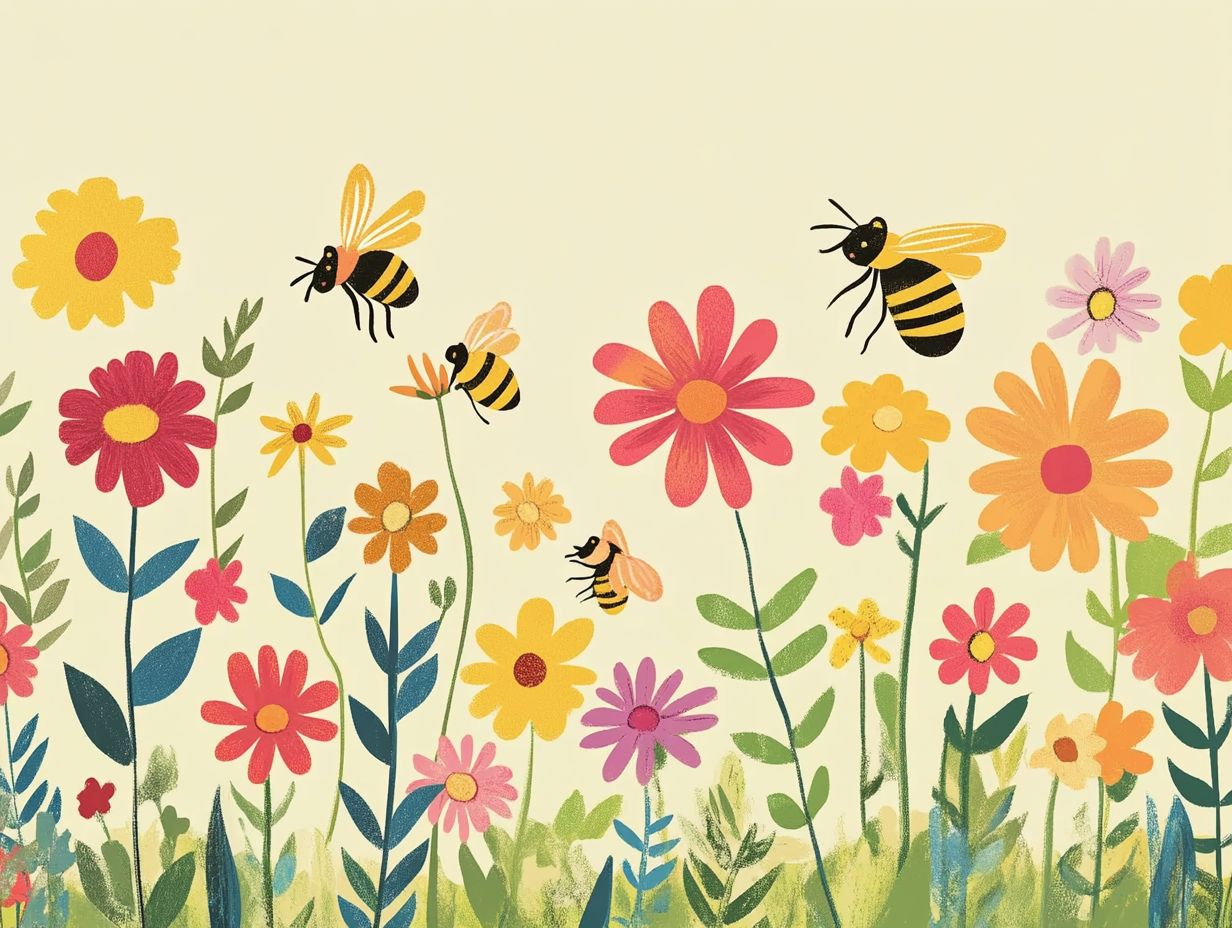
Supporting native bees in your community is not just a noble endeavor; it s an opportunity to engage in impactful initiatives like habitat restoration, education, and advocacy for conservation measures. Connect with local organizations and communities to raise awareness about the critical role these pollinators play in our ecosystem.
One of the most effective ways you can make a difference is by joining conservation programs, which provide valuable resources and activities designed to protect bee habitats. Take the lead by planting native flora in your gardens or community spaces, ensuring that bees have a reliable and sustainable food source.
By spreading the word about the importance of native bees, you not only enhance community knowledge but also inspire others to join these vital efforts. Organizations like the Xerces Society are key players in this mission, offering guidance and support, while local initiatives foster collaboration and education focused on preserving biodiversity and bolstering the health of these essential pollinators.
Frequently Asked Questions
What are the benefits of keeping native bees?
There are several benefits to keeping native bees, including increased pollination, improved crop yields, and a more sustainable ecosystem.
How do native bees help with pollination?
According to studies from the USGS (United States Geological Survey), native bees, including Apis mellifera, play a crucial role in pollinating a wide variety of plants, enhancing agricultural productivity and supporting ecosystem stability.
Native bees, including species like the blue orchard bee and common carpenter bee, are important pollinators for many plants, including crops like macadamia and wildflowers. They are more efficient pollinators than honeybees (Apis mellifera), as they carry more pollen and visit a wider variety of plants.
Will keeping native bees benefit my garden?
Absolutely! Keeping native bees in your garden can supercharge your plants and boost their yield.
Native bees, like the rusty-patched bumblebee and the American bumblebee, are fantastic pollinators that help your garden thrive. Research by Rachael Winfree shows just how beneficial they can be.
How do native bees contribute to a sustainable ecosystem in the United States?
What role do native bees play in our ecosystem? They are crucial for maintaining a healthy environment.
Native bees help pollinate different kinds of flowers and crops, including almond trees, which is vital for many species’ survival. By supporting native bees, you help maintain biodiversity. Organizations like the Xerces Society and Environment America work to promote these important benefits.
Are there any economic benefits to keeping native bees?
Do native bees have an economic impact? Yes, they can increase crop yields and profits for farmers!
For example, native bees in the Finger Lakes region of New York have significantly boosted agricultural outputs. Native bees also help the local economy by providing pollination services for gardens and farms. Experts like Scott Black and Claire Kremen have highlighted these benefits.
How can I support and encourage native bees in my area?
How can you support native bees? Start by planting native flowers and plants that attract them!
Providing nesting sites and avoiding pesticides are also essential steps. Creating a bee-friendly environment can help preserve and increase the native bee population in your community. Organizations like the USGS and experts like Sarah Foltz Jordan in California emphasize the importance of these actions. Start your bee-friendly garden today and watch your plants flourish!

